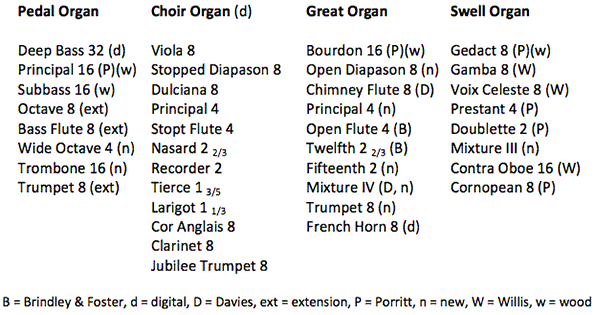ORGAN RECITAL PULLS OUT ALL THE STOPS
Reproduced here by kind permission of the The Advertiser this report
appeared in the week ending May 15, 2014 edition of the paper.
Reporter: Simon Meechan, Photographer: Matthew Phillips, Chief Photographer.
| The inaugural performance on the restored organ in St Michael's was a ‘great night’ says the church’s Musical Director Oliver Gooch right. On Saturday, May 3, 2014 more than 150 music-lovers gathered at the High Street church to hear the restored organ’s first recital. Richard Hills, the organist at St Mary’s Bourne Street, London, and the 2010 American Theatre Organ Society 'Organist of the Year’, played pieces by Percy |
 |
|
 |
||
The Organs of St. Michael’s Church Bray
The National Pipe Organ Register refers to a west gallery organ dating from 1859. This was probably the first organ to grace the church, music at Bray pre-1859 having presumably been supplied by a collection of instrumentalists along the lines of those that Hardy refers to from time to time. The west gallery was taken down in the course of the Great Reconstruction completed in 1862. The NPOR does not identify the organ-builder responsible for moving (and almost certainly altering) the organ, but it states that in 1895 Bevington worked on the instrument, and I imagine that the hand-blown organ that my father recalled from his boyhood was the organ as Bevington left it. In 1933, the history of the organs at Bray enters living memory, for in that year an organ of three manuals and pedals was installed by Henry Willis & Sons Limited, a famous organ-building company then under the direction of Henry Willis III, the grandson of its Victorian founder. The new organ was given as a memorial to William Sefton Riddelsdell, Vicar of Bray from 1915 until his death in 1931, and in 1937 it received a handsome case in memory of Ellen Rachel Butts, the wife of Herbert Butts (who in 1943 became a Churchwarden). This was the organ that I encountered in about 1962, when I joined the choir, and in abbreviated form its stop-list was as follows:

Facing south and occupying the space between the windows in the north wall of the chancel, the Willis organ had an electric blower (in the enclosure adjoining the door to the Vicar’s vestry), tubular-pneumatic action, and a nicely appointed draw-stop console; and in addition to the thirty speaking stops indicated above there were nine couplers, two tremulants, and eighteen pistons. The Choir Organ was enclosed.

The three-manual Willis was a miniature cathedral organ. Much of it spoke on relatively heavy wind-pressures (so that it could be heard in the nave) and its brilliant Great chorus, powerful reeds and thunderous Pedal basses combined to produce a most impressive Full Organ. Indeed, as a chorister I came to dread the third verse of Psalm 46 (‘Though the waters thereof rage and swell: and though the mountains shake at the tempest of the same’) for the organist - Reginald Payton Wheeler (1900-1988) - invariably used Full Organ at this point, and the effect in the chancel was overwhelming. But there were some charming quiet voices, and in many respects the instrument was a typical example of an inter-war church organ of medium size. By the early 1960s its mechanical condition had become a source of anxiety. The buckets of water kept inside it in order to maintain relative humidity failed to arrest its decline, and early in 1966 the leatherwork failed to such an extent that the organ had to be abandoned. As a temporary measure, a one-manual organ by Henry Willis 4 was installed on the south side of the chancel and performed wonders whilst its elder brother was being repaired. The latter was placed in the hands of Hill, Norman & Beard, who installed a humidifier, worked on its pneumatic motors, and gave it an Indian summer beginning towards the end of 1966 and lasting until 1969, when it was dismantled by Alfred E. Davies & Son of Northampton. When the site had been cleared, it was possible for the first time in over a century to have an uninterrupted view of the window at the east end of the north aisle. The new vista was so much admired that the authorities quickly abandoned the plan to put the rebuilt organ back in the chancel. Instead, it was put on a platform erected inside the choir vestry (thus blocking the Coney window, at the west end of the north aisle) and its pipes and mechanism were screened by the upper half of the 1937 case (the lower half of this fine memorial having been discarded). The Davies instrument had two manuals and pedals and electro-pneumatic action, and its detached, stop-key console was placed with the choir-stalls (which in 1968 had been moved from the chancel to the north side of the new sanctuary). It was dedicated on 27 September 1970.
In 1978, the choir-stalls returned to the chancel, and the organ console accompanied them. By now the novelty of the Davies organ had worn off, and it was gradually acknowledged that the work done in 1969-70 had been misguided: the instrument was adequate for congregational singing, and for certain parts of the repertoire, but it was wanting in finish and subtlety, and visually it left much to be desired; and after the turn of the century thoughts turned more and more to the possibility of a new organ in the chancel. Completed in 2013 and dedicated by the Bishop of Reading on 9 February 2014, the present organ is the work of Peter Collins Limited of Melton Mowbray. The remains of the 1937 case have undergone a beautiful transformation, one consequence of which is the prominence now given to its fine carving. Inside is a substantial electro-pneumatic pipe organ of two manuals and pedals, enhanced by a pipe-less Choir Organ and two other digital stops. Although some of the pipework is new, in accordance with the best traditions of British organ- building, some of it is recycled.
As the last survivor of those who regularly played the Willis organ, I congratulate St Michael’s on this elegant acquisition, and on restoring the grandeur I recall so vividly.
Dr Relf Clark © 2014
Peter Collins Ltd - traditional values with forward thinking
Peter Collins began a career in organ building with an indentured apprenticeship with a long established London firm. Further training and experience was gained by working with one of the most imaginative and inspiring organ builders of the twentieth century in mainland Europe. During a long training period an extremely varied range of work was encountered from instruments several centuries old to the most up to date and well engineered mechanical instruments of up to four manuals.
A business and workshop was set up in 1964 south of St Albans, Hertfordshire, work for and interest in the company was abundant, expansion was required and this was achieved with the purchase of an old school in Redbourn and enlargement of the workforce. Many instruments were constructed for the home and export markets as well as specialist restorations where the now accepted principles of conservation were applied then. Towards the end of the 1980’s it was obvious an expanded workforce and larger premises were required. Melton Mowbray, famous for pies and cheese, offered an excellent opportunity for a purpose built workshop with the further option for future expansion.
The company was moved in the middle of 1989 into the new premises, new machinery and an efficient layout all contribute towards constructing a quality product in an economical way.
Many notable instruments from Melton Mowbray have been created with the multi-skilled personnel we have been able to recruit. To date the company has made and installed new instruments in north and south America, near the Arctic Circle and in dry and sub tropical parts of Australia as well as five countries in Europe. All instruments have survived these extremes of climate due to our meticulous approach to the technical design and suitability of each component for the purpose required. Alongside our new instrument construction we have a team working with older instruments, here the emphasis is to retain the status quo wherever possible and desirable. Many times older parts are broken or missing, we take great pride to re-create items in the style of the original master.
Peter Collins (died 24th October 2015) in a personal capacity had written many articles, given lectures to a wide variety of interested people from professional bodies to university students. Peter Collins was a past member and a past president of the Federation of Master Organ Builders, a past member of the organ committee to the Council for the Care of Churches, and was a board member of the Institute of British Organ Builders, the industry's professional body.

